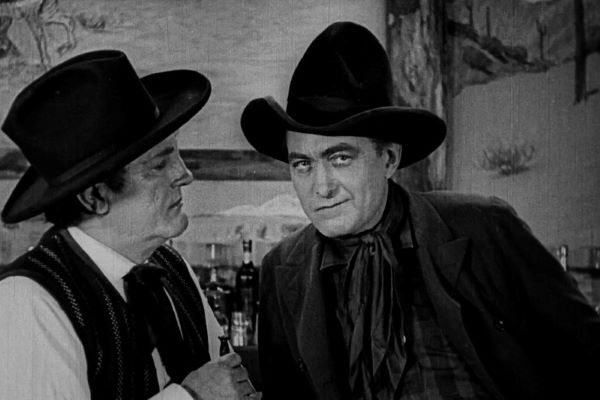We have an image of John Ford in the latter stages of his career as the elder statesman of the American western; the hat, pipe and dark glasses combo. It’s often forgotten just how influential he was in shaping the genre as we know it. The format of the feature-length film was still being established when the young Ford, fuelled by a competitive relationship with his older and more established brother Francis, directed his first feature Straight Shooting in 1917. This was one of 25 films of various lengths he made with early western icon Harry Carey in the recurring role of Cheyenne Harry. Most are lost or incomplete, although his debut has been paired with Hell Bent, from 1918. The later film is nine films on in the series, but the next to survive intact. Historical importance aside, it’s astonishing how Ford was using the style and symbolism that would become stereotypical of the genre this early in its formation. They also hold up remarkably well as brisk, rollicking adventures with an appealing, careworn anti-hero in the shape of Cheyenne Harry.
Straight Shooting immediately set out the template for Carey’s character, a tough mercenary with weathercock morals. Harry is recruited by a ruthless gang of ranchers to sabotage the access to water of a family of farmers. After witnessing the shooting of the farmer’s son, Harry turns against the cattlemen and helps defends the farmstead. And at the end, he rides off into the sunset – the elegiac ending that would be emulated a million times over, not least by Ford himself. Already present are his themes of the outsider choosing to briefly engage with an emerging society he doesn’t always understand. Surprisingly morally complex and incredibly assured in its composition and stunt work, it’s an impressive and fully-formed compact debut.
By the time of Hell Bent the formula for the adventures of Cheyenne Harry was firmly established. It seems that Carey’s character goes through a reset between films as once more he’s a surly, drunken good-for-nothing before his moral compass ends up pointing due North again. Interestingly he’s set up here as an overtly fictional character created by a novelist tasked with creating a hero possessing both good and bad qualities; a very early example of self-reflexivity in cinema. Carey is wearing Cheyenne like a comfy suit by this point, and his acting style has evolved to a point we could term ‘mercurial smoking’, given that the way he puffs on, or extinguishes, his ever-present roll-up is indicative of his mood at the time.
Hell Bent also sees Cheyenne developing a drunken bromance with Cimmaron Bill (Duke R. Lee, also appearing as a villain in Straight Shooting), formed principally around a shared love for the song ‘Sweet Genevieve‘. Composer Zachary Marsh, in his sprightly new score for the restoration, deftly accommodates the tune as a frequent leitmotif. Ford foregrounds humour far more prominently in Hell Bent, perhaps indicating the evolution of Cheyenne as collaboration between director and star. The basic plot sees Cheyenne and Bill overcoming bandits and sandstorms in a trek across the desert to rescue Harry’s sweetheart Bess (Neva Gerber); as staple a narrative as you’ll see. But once again, Ford impresses with go-for-broke stunts and imaginative camerawork – the frame shrinking to highlight a lamp as the sole source of light in a room, for instance – and it’s that much more fun than its seminal predecessor.
Early westerns are always interesting, coming as they did within living memory of the times they depict. The late historian and author Eric Hobsbawm characterises the myth of the cowboy as nestling between dichotomies; “the confrontation of nature and civilisation, and of freedom with social constraint.” You can see this conflict in Cheyenne Harry and it informs Ford’s career right through to its apotheosis in The Searchers. You can see the elegiac nature of the western in these two films, taking the fluid tales and legends (some of whom were still alive and concerned with buffing their reputations as they aged) and hardening them into something like a chrysalis phase. There they would settle into formula for 50 years until the violent and revisionist western (such as McCabe & Mrs Miller, The Wild Bunch, High Plains Drifter, and El Topo) arrived at the same time as New Hollywood shook the entire industry from its Hays Code-induced torpor. This period also coincided with John Ford’s irascible, but somewhat poetically fitting, retirement.
Those lawless old days may never have existed as he depicted them, but the way we visualise the old American west was shaped by John Ford as much as anyone in cinematic history. In these two early films, we can see the germination of one of the greatest careers in American film.
Available on Blu-ray from Mon 19 Apr 2021
